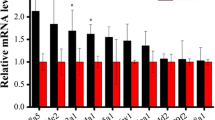Abstract
To prove the rate of enzymatic detoxication in resistance, a direct correlation between the degree of insecticide resistance with the enzyme system concentration within the insect must be shown. Thus, in the housefly, DDT* is readily converted to DDE by cell-free preparations and the resistance appears to be proportional to the DDT-dehydrochlorinase activity1. DDT is also metabolized to a ‘Kelthane’-like material by a microsomal enzyme system, in several insect species, including Triatoma infestans2,3. However, no significant data are available on the possible relation of DDT-hydroxylation to resistance. Correlation between the level of enzymatic detoxication and resistance can be shown by in vivo specific inhibition or stimulation of the enzymatic process, resulting in decreased or increased resistance, respectively. In this respect, it is known that SKF 525–A and other compounds, such as iproniazid, block microsomal hydroxylation reactions4, while 3-methylcholanthrene acts like an activator5. By using this last approach, it has been possible to show that the degree of tolerance to DDT by nymph T. infestans can be modified by the foregoing inhibitors and activators, suggesting that DDT-hydroxylation plays indeed a part in resistance.
Similar content being viewed by others
References
Sternburg, J. E., Kearns, C. W., and Moorfield, H. H., Agric. Food. Chem., 2, 1125 (1954).
Agosin, M., Michaeli, D., Miskus, R., Nagasawa, S., and Hoskins, W. M., J. Econ. Entomol., 54, 340 (1961).
Dinamarca, M. L., Agosin, M., and Neghme, A., Exp. Parasitol., 12, 61 (1962).
Fouts, J. R., and Brodie, B. B., Exp. Therap., 116, 480 (1956).
Nasu, H., and Sakamoto, J., J. Biochem., 52, 351 (1962).
Agosin, M., Scaramelli, N., and Neghme, A., Comp. Biochem. Physiol., 2, 143 (1961).
Sternburg, J., and Kearns, C. W., J. Econ. Entomol., 45, 505 (1952).
Hewlett, P. S., Lloyd, C. D., and Bates, A. N., Nature, 192, 1273 (1961).
Terriere, L. C., W.H.O. Information Circ. Insecticide Resistance, 37, 7 (1963).
Author information
Authors and Affiliations
Rights and permissions
About this article
Cite this article
MORELLO, A. Role of DDT-hydroxylation in Resistance. Nature 203, 785–786 (1964). https://doi.org/10.1038/203785a0
Published:
Issue Date:
DOI: https://doi.org/10.1038/203785a0
- Springer Nature Limited
This article is cited by
-
A glutamate-gated chloride channel as the mite-specific target-site of dicofol and other diphenylcarbinol acaricides
Communications Biology (2023)
-
10.1007/BF00295308
CrossRef Listing of Deleted DOIs (2011)
-
Insect cytochrome P-450
Molecular and Cellular Biochemistry (1976)





